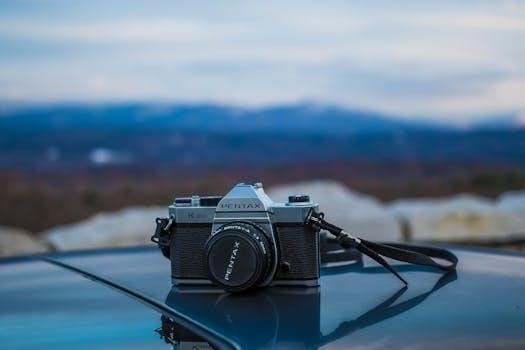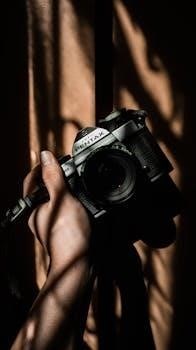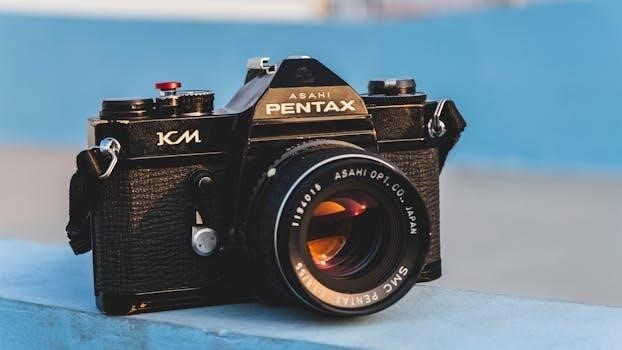
The Pentax K1000 is an iconic, fully manual 35mm SLR film camera, renowned for its simplicity and robust design. This camera serves as an excellent tool for learning photography fundamentals. Its user-friendly interface makes it a popular choice.
Overview of the Pentax K1000
The Pentax K1000 stands out as a classic, entry-level 35mm film SLR camera, celebrated for its straightforward, all-manual operation. It features a robust, mostly metal body, designed for durability and reliability. Its mechanical design provides a direct connection to the photographic process, making it an ideal learning tool for aspiring photographers. The K1000 emphasizes essential controls such as aperture, shutter speed, and focus, fostering a deeper understanding of photographic principles. This simplicity allows photographers to focus on the art of image creation, without complex features or settings. The camera’s popularity has made it a widely available and affordable option for film enthusiasts, and its timeless design continues to attract new users.
Basic Operation
Operating the Pentax K1000 involves understanding film loading, setting shutter speed and aperture, and utilizing the built-in light meter. This section will guide you through these essential steps.
Loading Film into the K1000
To load film, first, open the camera back by lifting the rewind knob. Insert the film canister into the chamber and pull the film leader across to the take-up spool. Ensure the film is properly engaged with the sprockets. Advance the film using the film advance lever until the counter shows ‘1’. Close the camera back and continue advancing the film twice more to ensure the film is correctly positioned. Now, your Pentax K1000 is ready for shooting your first frame. Remember to always handle the film with care.
Setting Shutter Speed and Aperture
The Pentax K1000 offers manual control over shutter speed and aperture. To set the shutter speed, rotate the dial located on the top of the camera, selecting your desired speed. Aperture is adjusted using the ring on the lens, choosing the desired f-number. These settings work together to control the amount of light that reaches the film. Understanding this relationship is crucial for achieving well-exposed images. Experiment with different combinations to see the impact on your photos. Remember, proper exposure is key to capturing great shots with your K1000.
Using the Light Meter
The Pentax K1000 features a built-in light meter to assist with proper exposure. To activate it, remove the lens cap. The meter uses a needle in the viewfinder. Adjust the shutter speed and aperture until the needle is centered in the window. This indicates a correctly exposed image. For accurate metering, set the film speed. The light meter is a helpful guide, but it’s essential to understand that it may not always be perfect. In complex lighting situations, it’s often best to use your judgment and adjust as necessary.

Lens Compatibility and Usage
The K1000 primarily uses SMC Pentax and SMC Pentax-M lenses. It can also be adapted to use other lens types; however, this might require additional adapters. Understanding lens compatibility is crucial.
SMC Pentax and Other Lens Types
The Pentax K1000 is designed to work most effectively with SMC Pentax and SMC Pentax-M lenses, which are known for their quality and compatibility with the camera’s metering system. While the K1000 is primarily designed for these lenses, it’s possible to use other lens types with adaptors. However, the K1000 may not operate as intended when using KA or KAF mount lenses like SMC Pentax-A or SMC Pentax-F lenses, requiring different operation methods. The camera’s full potential is realized with its designed lenses, ensuring proper functionality and accurate light readings. Knowing the lens type is essential.
Adapting Lenses for the K1000
While the Pentax K1000 is designed primarily for K-mount lenses, using other lens types is possible with adapters. However, it’s crucial to understand limitations. Some lenses may not fully integrate with the camera’s metering, requiring manual adjustments. Adapting lenses introduces potential incompatibilities, especially with automatic features. Unlike cameras like the Pentax Spotmatic or Fujica ST-701, which accept a broader range of lenses without hassle, the K1000 may require careful consideration. When using adapted lenses, it’s important to verify compatibility and be prepared to operate the camera in full manual mode for optimal results and to adjust your usage of the light meter.

Advanced Features and Techniques
The K1000, while basic, allows for creative techniques. Understanding depth-of-field and utilizing multiple exposures can enhance your photography. These features offer ways to expand creative expression.
Depth-of-field Guide
Understanding depth-of-field is crucial for creative control with the Pentax K1000. This refers to the area of your image that appears acceptably sharp. A wide aperture, like f/2, creates a shallow depth-of-field, blurring the background and isolating the subject, while a narrow aperture, such as f/16, results in a greater area in focus. The lens’s focal length also affects depth-of-field, with longer focal lengths producing shallower fields. Use the lens’s depth-of-field scale and preview lever, if available, to visualize the area of sharpness before capturing your image, allowing for more intentional photographic choices. Mastering this element allows for more artistic and engaging photography.
Multiple Exposure
The Pentax K1000, while primarily known for its simplicity, does offer a way to create multiple exposures, though it requires a manual workaround. To achieve this effect, after taking the first exposure, do not advance the film. Instead, hold the rewind button on the bottom of the camera, while carefully recocking the shutter. This allows you to expose the same frame again. This technique allows you to layer images for creative effects. Remember that each exposure will add to the overall light hitting the film, so you may need to compensate for this by underexposing each shot accordingly. Experimentation is key to mastering multiple exposure.

Maintenance and Troubleshooting
Maintaining your Pentax K1000 ensures its longevity. Regular checks include battery assessment and addressing common issues. This section provides solutions for optimal camera performance and extended use.
Battery Check and Replacement
The Pentax K1000 utilizes a small battery solely for its light meter; the camera itself operates mechanically. To check the battery, set the ISO to 100 and the shutter speed dial to ‘B’. If the meter needle moves upwards when the shutter button is half-pressed, the battery is likely functional. If the needle does not move or is sluggish, it’s time for a replacement. The K1000 typically uses a small 1.5V silver oxide battery, such as the LR44 or SR44. To replace it, carefully open the battery compartment, usually located at the camera’s bottom, remove the old cell, and insert the new one with correct polarity, ensuring it makes proper contact. Always verify meter functionality after replacement.
Common Issues and Solutions
Several common issues may arise with the Pentax K1000. A sticky shutter can result from old lubricants; a professional cleaning is often the best solution. If the light meter is inaccurate, first check the battery; if that’s not the problem, the meter cells might require calibration or replacement. Film transport problems could stem from incorrect loading or worn gears; ensure the film is properly loaded and the rewind crank is working smoothly. A misaligned frame counter indicates a problem in the internal mechanics; a service manual can guide you to disassembly. Finally, check for lens compatibility issues and use only the correct lenses for the Pentax K mount.

Additional Resources
For further assistance, numerous online resources offer valuable information. These include service manuals, user manuals, and online forums where users share their experiences and solutions regarding the K1000.
Service Manual Information
While a dedicated Pentax K1000 service manual is concise, it often references the Pentax KX or KM service manuals. These models share significant internal similarities with the K1000, making their service information applicable. The K1000 service manual mainly highlights the differences between the K1000 and these other cameras, which is useful for repairs. These comprehensive manuals provide detailed diagrams, schematics, and instructions for disassembly, assembly, and troubleshooting. They are essential resources for those looking to perform more advanced repairs or maintenance on their Pentax K1000, offering a deeper understanding of the camera’s internal workings and mechanical components.
Where to Find User Manuals
Numerous online resources offer free Pentax K1000 user manuals in PDF format. Websites like Manualslib and cameramanuals.org provide downloadable manuals, sometimes with the password “Pentax.” These manuals are invaluable for understanding the camera’s operation and features, especially for new users. Several websites host scanned versions of the original Pentax K1000 instruction manual. Some resources offer both user manuals and service manuals, which can be beneficial for troubleshooting. It is also possible to find manuals on sites such as archive.org, which provides a wealth of historical documents, including camera manuals from various manufacturers. These resources are a great help for owners who do not have the original manual.